
EN4: Dynamics and Vibrations
Division of Engineering
Brown University
6.4 Free vibration of a conservative, single degree of freedom, linear spring mass system.
First, we will explain what is meant by the title of this section.

EN4: Dynamics and Vibrations
Division of Engineering
Brown University
6.4 Free vibration of a conservative, single degree of freedom, linear spring mass system.
First, we will explain what is meant by the title of this section.
![]() Recall
that a system is conservative if energy is conserved, i.e. potential energy +
kinetic energy = constant during motion.
Recall
that a system is conservative if energy is conserved, i.e. potential energy +
kinetic energy = constant during motion.
![]() Free
vibration means that no time varying external forces act on the system.
Free
vibration means that no time varying external forces act on the system.
![]() A
system has one degree of freedom if its motion can be described by a single scalar
variable.
A
system has one degree of freedom if its motion can be described by a single scalar
variable.
![]() A
system is said to be linear if its equation of motion is linear. We will see what
this means shortly.
A
system is said to be linear if its equation of motion is linear. We will see what
this means shortly.
It turns out that all 1DOF, linear conservative systems behave in exactly the same way. By analyzing the motion of one representative system, we can learn about all others.
We will follow standard procedure, and use a spring-mass system as our representative example.
Problem: The spring mass system is released with velocity
from position
at time
. Find
.
There is a standard approach to solving problems like this
(i) Get a differential equation for s using F=ma (or other methods to be discussed)
(ii) Solve the differential equation.
The picture shows a free body diagram for the mass. Newton II states that
This is our equation of motion for s.
Now, we need to solve this equation. We will cheat. Since we do not have time to cover the necessary mathematics, we will look up the solution. If you are curious and/or highly advanced in math, you can download a handout (pdf format) that describes the solution procedure in detail. If not, you can wait until this material is covered in AM33 and AM34.
We therefore consult a handy list of solutions to differential equations , (This list of solutions is available in pdf format if you wish to print it out. The list of solutions may be used in examinations) and observe that it gives the solution to the following equation
This is very similar to our equation, but not identical. We need to massage our equation a bit to make it look right. To this end, let
Note that d is constant, so when these are substituted into our equation of motion, it reduces to the standard form. The solution for x is
Here,
and
are the initial value of x and its time derivative, which must be computed from the initial values of s and its time derivative
Finally, we can compute s
Observe that:
![]() The mass oscillates harmonically, as discussed in the preceding section;
The mass oscillates harmonically, as discussed in the preceding section;
![]() The angular frequency of oscillation,
The angular frequency of oscillation, ![]() , is a characteristic property of the system, and is independent of the
initial position or velocity of the mass. This is a very important observation, and we
will expand upon it below. The characteristic frequency is known as the natural
frequency of the system.
, is a characteristic property of the system, and is independent of the
initial position or velocity of the mass. This is a very important observation, and we
will expand upon it below. The characteristic frequency is known as the natural
frequency of the system.
![]() Increasing the stiffness of the spring increases the natural frequency of the system;
Increasing the stiffness of the spring increases the natural frequency of the system;
![]() Increasing the mass reduces the natural frequency of the system.
Increasing the mass reduces the natural frequency of the system.
6.5 Natural Frequencies and Mode Shapes.
We saw that the spring mass system described in the preceding section likes to vibrate at a characteristic frequency, known as its natural frequency. This turns out to be a property of all stable mechanical systems.
All stable, unforced, mechanical systems vibrate harmonically at certain discrete frequencies, known as natural frequencies of the system.
For the spring—mass system, we found only one natural frequency. More complex systems have several natural frequencies. For example, the system of two masses shown below has two natural frequencies, given by
A system with three masses would have three vibration frequencies, and so on.
In general, a system with more than one natural frequency will not vibrate harmonically.
For example, suppose we start the two mass system vibrating, with initial conditions
The response may be shown to be
with
In general, the vibration response will look complicated, and is not harmonic. However, if we choose the special initial conditions:
then the response is simply
i.e., both masses vibrate harmonically, at the first natural frequency. Similarly, if we choose
then
i.e., the system vibrates harmonically, at the second natural frequency.
The special initial displacements of a system that cause it to vibrate harmonically are called `mode shapes’ for the system.
If a system has several natural frequencies, there is a corresponding mode of vibration for each natural frequency.
The natural frequencies and mode shapes are arguably the single most important property of any mechanical system. This is because, as we shall see, the natural frequencies coincide (almost) with the system’s resonant frequencies. That is to say, if you apply a time varying force to the system, and choose the frequency of the force to be equal to one of the natural frequencies, you will observe very large amplitude vibrations.
When designing a mechanical system, you want to make sure that the natural frequencies of vibration are much larger than any excitation frequency that the system is likely to see.
A beautiful example of this kind of design exercise can be found at the homepage of NASA’s Goddard Space Flight Center, where natural frequencies and vibration modes are calculated for the Mars Orbiter Laser Altimeter. Tha animations below show some of the mode shapes for the system, predicted using a computer simulation technique known as Finite Element Analysis. The amplitude of vibration has been greatly exaggerated for clarity - the real system could never withstand displacements as large as those shown below!
Modes 1 and 2:
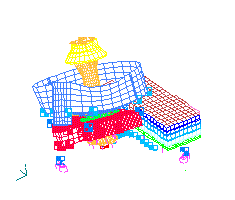
Modes 5 and 6
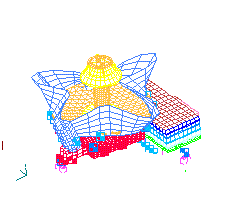
Once a prototype has been built, it is usual to measure the natural frequencies and mode shapes for a system. This is done by attaching a number of accelerometers to the system, and then hitting it with a hammer (this is usually a regular rubber tipped hammer, but vibration consultants like to call them `impulse hammers’ so they can charge more for their services). By trial and error, one can find a spot to hit the device so as to excite each mode of vibration independent of any other. You can tell when you have found such a spot, because the whole system vibrates harmonically. The natural frequency and mode shape of each vibration mode is then determined from the accelerometer readings.
Impulse hammer tests can even be used on big structures like bridges or buildings – but you need a big hammer. In a recent test on a new cable stayed bridge in France, the bridge was excited by first attaching a barge to the center span with a high strength cable; then the cable was tightened to raise the barge part way out of the water; then, finally, the cable was released rapidly to set the bridge vibrating.
6.6 Calculating natural frequencies for 1DOF conservative systems
In light of the discussion in the preceding section, we clearly need some way to calculate natural frequencies for mechanical systems. We do not have time in this course to discuss more than the very simplest mechanical systems. We will therefore show you some tricks for calculating natural frequencies of 1DOF, conservative, systems. It is best to do this by means of examples.
Example 1: A linear system.
Calculate the natural frequency of vibration for the system shown below
Assume that the cylinder rolls without slip on the wedge.
Our first objective is to get an equation of motion for s. We do this by writing down the potential and kinetic energies of the system in terms of s.
The potential energy is easy:
The first term represents the energy in the spring, while second term accounts for the gravitational potential energy.
The kinetic energy is slightly more tricky. Note that the magnitude of the angular velocity of the disk is related to the magnitude of its translational velocity by
Thus, the combined rotational and translational kinetic energy follows as
Now, note that since our system is conservative
Differentiate our expressions for T and V to see that
The last equation is almost in one of the standard forms given on the list of solutions, except that the right hand side is not zero. There is a trick to dealing with this problem – simply subtract the constant right hand side from s, and call the result x. (This only works if the right hand side is a constant, of course). Thus let
and substitute into the equation of motion:
This is now in the form
and by comparing this with our equation we see that the natural frequency of vibration is
Summary of procedure for calculating natural frequencies:
(1) Describe the motion of the system, using a single scalar variable (In the example, we chose to describe motion using the distance s);
(2) Write down the potential energy V and kinetic energy T of the system in terms of the scalar variable;
(3) Use ![]() to get an equation of motion for your scalar variable;
to get an equation of motion for your scalar variable;
(4) Arrange the equation of motion in standard form;
(5) Read off the natural frequency by comparing your equation to the standard form.
Example 2: A nonlinear system.
We will illustrate the procedure with a second example, which will demonstrate another useful trick.
Find the natural frequency of vibration for a pendulum, shown below.
We will idealize the mass as a particle, to keep things simple.
We will follow the steps outlined earlier:
(1) We describe the motion using the angle
(2) We write down T and V:
(3) Differentiate with respect to time:
(4) Arrange the EOM into standard form. Houston, we have a problem. There is no way this equation can be arranged into standard form. This is because the equation is nonlinear (
is a nonlinear function of
). There is, however, a way to deal with this problem. We will show what needs to be done, summarizing the general steps as we go along.
(i) Find the static equilibrium configuration(s) for the system.
If the system is in static equilibrium, it does not move. We can find values of ![]() for which the system is in static
equilibrium by setting all time derivatives of
for which the system is in static
equilibrium by setting all time derivatives of ![]() in the equation of motion to zero, and then solving
the equation. Here,
in the equation of motion to zero, and then solving
the equation. Here,
![]()
Here, we have used ![]() to
denote the special values of
to
denote the special values of ![]() for which the system happens to be in static equilibrium. Note that
for which the system happens to be in static equilibrium. Note that ![]() is always a constant.
is always a constant.
(ii) Assume that the system vibrates with small amplitude about a static equilibrium configuration of interest.
To do this, we let ![]() , where
, where ![]() .
.
Here, x represents a small change in angle from an equilibrium configuration.
x will vary with time as the system vibrates. Instead of solving for ![]() , we will solve for x.
Before going on, make sure that you are comfortable with the physical significance of both
x and
, we will solve for x.
Before going on, make sure that you are comfortable with the physical significance of both
x and ![]() .
.
(iii) Linearize the equation of motion, by expanding all nonlinear terms as Taylor Maclaurin series about the equilibrium configuration.
We substitute for ![]() in the
equation of motion, to see that
in the
equation of motion, to see that

(Recall that ![]() is constant,
so its time derivatives vanish)
is constant,
so its time derivatives vanish)
Now, recall the Taylor-Maclaurin series expansion of a function f(x) has the form
![]()
where

Apply this to the nonlinear term in our equation of motion
![]()
Now, since x<<1, we can assume that ![]() , and so
, and so
![]()
Finally, we can substitute back into our equation of motion, to obtain

(iv) Compare the linear equation with the standard form to deduce the natural frequency.
We can do this for each equilibrium configuration.

whence
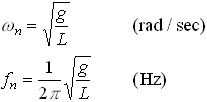
Note that all these values of ![]() really represent the same configuration: the mass is hanging below the
pivot. We have rediscovered the well-known expression for the natural frequency of a
freely swinging pendulum.
really represent the same configuration: the mass is hanging below the
pivot. We have rediscovered the well-known expression for the natural frequency of a
freely swinging pendulum.
Next, try the remaining static equilibrium configuration

If we look up this equation in our list of standard solutions, we find it does not have a harmonic solution. Instead, the solution is
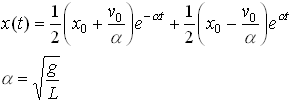
where ![]() and
and 
Thus, except for some rather special initial conditions, x increases without bound as time increases. This is a characteristic of an unstable mechanical system.
If we visualize the system with ![]() , we can see what is happening. This equilibrium configuration has the
pendulum upside down!
, we can see what is happening. This equilibrium configuration has the
pendulum upside down!
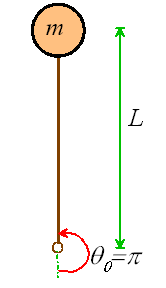
No wonder the equation is predicting an instability…
Here is a question to think about. Our solution predicts that both x and dx/dt become infinitely large. We know that a real pendulum would never rotate with infinite angular velocity. What has gone wrong?
We will look at one more nonlinear system, to make sure that you are comfortable with this procedure.
Example 3: Calculate the resonant frequency of small oscillations about the
equilibrium configuration ![]() for the system below.
for the system below.
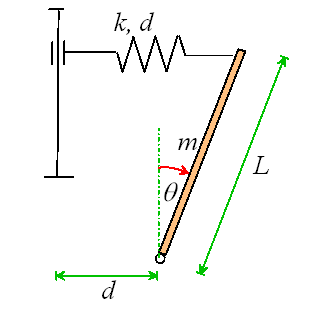
We follow the same procedure as before.
The potential and kinetic energies of the system are
Hence
Once again, we have found a nonlinear equation of motion. This time we know what to do. We are told to find natural frequency of oscillation about
, so we don’t need to solve for the equilibrium configurations this time. We set
, with
and substitute back into the equation of motion:
Now, expand all the nonlinear terms (it is OK to do them one at a time and then multiply everything out. You can always throw away all powers of x greater than one as you do so)
We now have an equation in standard form, and can read off the natural frequency
Question: what happens for
?